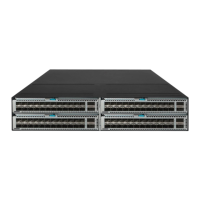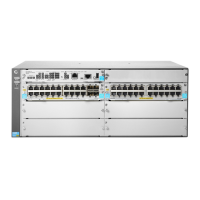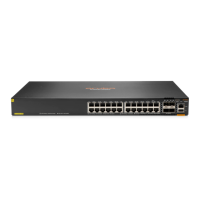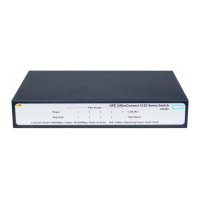7
Configuring generic flow control on an Ethernet interface
To avoid dropping packets on a link, you can enable generic flow control at both ends of the link.
When traffic congestion occurs at the receiving end, the receiving end sends a flow control (Pause)
frame to ask the sending end to suspend sending packets. Generic flow control includes the
following types:
• TxRx-mode generic flow control—Enabled by using the flow-control command. With
TxRx-mode generic flow control enabled, an interface can both send and receive flow control
frames:
{ When congestion occurs, the interface sends a flow control frame to its peer.
{ When the interface receives a flow control frame from its peer, it suspends sending packets
to its peer.
• Rx-mode generic flow control—Enabled by using the flow-control receive enable
command. With Rx-mode generic flow control enabled, an interface can receive flow control
frames, but it cannot send flow control frames:
{ When congestion occurs, the interface cannot send flow control frames to its peer.
{ When the interface receives a flow control frame from its peer, it suspends sending packets
to its peer.
To handle unidirectional traffic congestion on a link, configure the flow-control receive enable
command at one end and the flow-control command at the other end. To enable both ends of a link
to handle traffic congestion, configure the flow-control command at both ends.
To enable generic flow control on an Ethernet interface:
Step Command Remarks
1. Enter system view.
system-view
N/A
2. Enter Ethernet interface
view.
interface
interface-type
interface-number
N/A
3. Enable generic flow
control.
• Enable TxRx-mode
generic flow control:
flow-control
• Enable Rx-mode generic
flow control:
flow-control receive
enable
By default, generic flow control is
disabled on an Ethernet interface.
Configuring PFC on an Ethernet interface
When congestion occurs in the network, the local device notifies the peer to stop sending packets
carrying the specified 802.1p priority if all of the following conditions exist:
• Both the local end and the remote end have PFC enabled.
• Both the local end and the remote end have the priority-flow-control no-drop dot1p
command configured.
• The specified 802.1p priority is in the 802.1p priority list specified by the dot1p-list argument.
• The local end receives a packet carrying the specified 802.1p priority.
The state of the PFC feature is determined by the PFC configuration on the local end and on the peer
end. In Table 1:
• The first row l
ists the PFC configuration on the local interface.
• The first column lists the PFC configuration on the peer.

